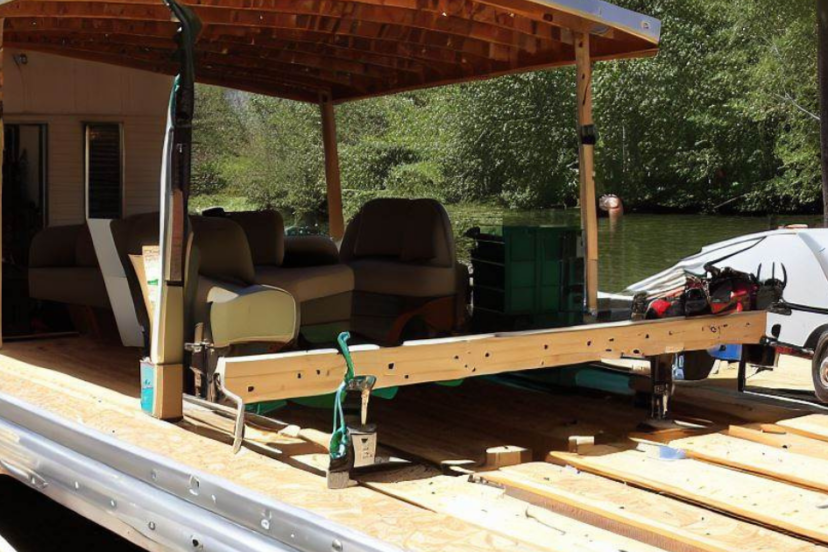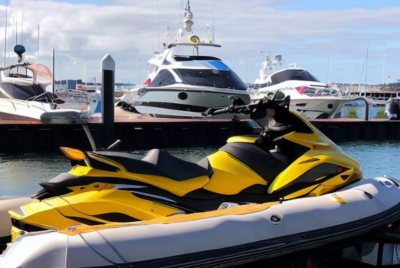I am excited to share with you the world of DIY pontoon boat building. In this guide, we’ll explore the benefits of building your own pontoon boat, the planning process, required materials and tools, step-by-step construction instructions, safety considerations, maintenance tips, and more. Get ready to embark on a thrilling journey of creating your very own DIY pontoon boat!
Benefits of Building a DIY Pontoon Boat
Building a DIY pontoon boat offers several advantages that make it an enticing project for watercraft enthusiasts. Firstly, it provides significant cost savings compared to purchasing a pre-built boat. By sourcing materials and doing the work yourself, you can save a substantial amount of money without compromising on quality.Personalize your boat by adding decorative elements, such as decals or graphics. Consider non-slip deck coatings or mats for added safety and convenience. Also consider the following key accessories as you build, a
Captain’s Chair,
Boat Rod Holders,
Boat Anchor,
Bimini Top and
Pontoon Boat Trailer for safely transporting your newly built Pontoon Boat.
Secondly, building your own pontoon boat allows for customization. You have the freedom to design and create a watercraft that perfectly suits your preferences and needs. Whether you desire a specific layout, seating arrangement, or special features, the DIY approach grants you full control over the boat’s design.
Lastly, embarking on a DIY pontoon boat project is an incredible learning experience. You acquire valuable skills in boat construction, woodworking, and problem-solving. The sense of accomplishment that comes from completing such a challenging endeavor is unmatched.
Planning Your DIY Pontoon Boat Project
Before diving into the construction process, thorough planning is essential, to ensure the work and time effort pays. Start by researching different pontoon boat designs and sizes to determine the style that appeals to you. Consider factors such as the boat’s primary purpose, capacity, and desired features. This initial planning phase sets the foundation for a successful build.
Next, establish a realistic budget and timeline. Take into account the cost of materials, tools, and any additional expenses such as permits or licenses. A well-defined budget helps you make informed decisions throughout the project and ensures that you stay within your financial means.
Lastly, before you build or buy any materials, familiarize yourself with any regulations or requirements specific to your area. Check if there are any permits needed for constructing or operating a DIY pontoon boat. Adhering to local guidelines ensures that your boat is safe, legal, and ready for adventure.
Materials & Tool Box
To bring your DIY pontoon boat to life, you’ll need a variety of materials and tools. Here’s a list of the essentials:
Materials: Overview
- Marine-grade aluminum or steel for pontoons
- Pressure-treated lumber or marine-grade plywood for the framework and deck
- Stainless steel fasteners and hardware
- Waterproof adhesive and sealants
- Wiring, electrical components, and plumbing materials (if applicable for your design)
- Marine-grade paint and finishes
Tools: Overview
- Measuring tape and ruler
- Saw (circular, jigsaw, or miter saw)
- Drill and drill bits
- Screwdriver and screws
- Clamps and vices
- Wrenches and pliers
- Paintbrushes and rollers
- Safety equipment (goggles, gloves, ear protection)
It’s crucial to choose high-quality materials to ensure the durability and longevity of your pontoon boat. Opting for marine-grade components helps withstand the harsh marine environment.
Step-by-Step Guide to Building a DIY Pontoon Boat
8 Steps to consider
1. Designing the Pontoon Boat
Begin by creating a detailed plan for your pontoon boat. Consider factors such as size, weight capacity, seating arrangement, storage compartments, and any additional features you desire. Sketch your ideas or use design software to visualize the boat’s layout and structure. Also consider the
motor type relative to your boat size and style.
2. Gathering Materials
Once you have your design in place, it’s time to gather the necessary materials. Consult your plan to create a comprehensive shopping list. Seek out reputable suppliers that offer marine-grade aluminum or steel for the pontoons, pressure-treated lumber or marine-grade plywood for the framework and
deck flooring, and other materials specified in your design.
Comparing prices and quality is essential during the material acquisition phase. Look for cost-effective options without compromising on durability and safety.
3. Constructing the Framework
The framework serves as the backbone of your pontoon boat, providing stability and support. Begin by cutting the lumber or plywood according to your design specifications. Follow your plan and assemble the framework, ensuring accurate measurements and secure connections. Use clamps and screws to hold the components together, checking for levelness and alignment at each step. Pay special attention to reinforcing areas that will bear weight, such as the seating and engine mounts.
4. Attaching the Pontoons
With the framework in place, it’s time to attach the pontoons—the flotation devices that keep your boat afloat. There are various attachment methods to choose from, including welding, bolting, or using specialized brackets. Follow the manufacturer’s instructions and consult your design plan for the most suitable approach.
Ensure that the pontoons are evenly spaced and level with the framework. Double-check the connections to guarantee a secure and stable attachment. Proper alignment and balance are crucial for safe and efficient operation.
5. Building the Deck and Seating
The deck provides the platform for you and your passengers to enjoy the pontoon boat. Use marine-grade plywood or pressure-treated lumber to construct a sturdy and comfortable deck. Cut the materials according to your design plan and securely attach them to the framework, ensuring a smooth and level surface.
Next, focus on building the seating areas. Incorporate ergonomic considerations, such as backrests and cushioning, for optimal comfort. Install storage compartments beneath the seats to maximize space utilization.
6. Installing Electrical and Plumbing Systems (Optional)
If you wish to include electrical components, such as navigation lights, sound systems, or even basic lighting, now is the time to install them. Plan the wiring layout carefully and follow best practices for marine electrical systems to ensure safety and reliability.
For plumbing systems, such as freshwater tanks or onboard sinks, consult a professional or follow detailed instructions to ensure proper installation and prevent leaks or water damage.
7. Painting and Finishing Touches
With the structural elements in place, it’s time to add the finishing touches to your DIY pontoon boat. Choose a marine-grade paint or finish that offers protection against water, UV rays, and corrosion. Apply multiple coats for optimal durability.
8. Safety Considerations
During the construction process, prioritize safety at all times. Use appropriate safety equipment, such as goggles, gloves, and ear protection, when operating power tools. Take precautions to prevent accidents and injury.
When the boat is complete, familiarize yourself with boating safety regulations, including life jacket requirements, navigation rules, and emergency procedures. Be prepared for unforeseen circumstances and always prioritize the safety of yourself and your passengers.
Maintenance and Care for Your DIY Pontoon Boat
To ensure the longevity and optimal performance of your DIY pontoon boat, regular maintenance is essential. Create a maintenance schedule that includes tasks such as cleaning, inspecting for damage, and lubricating moving parts.
Regularly check for signs of wear, such as loose connections or rust, and address them promptly. Winterize your boat if necessary, following recommended procedures for storage and protection during colder months.
By investing time and effort into proper maintenance, you’ll extend the lifespan of your DIY pontoon boat and continue enjoying memorable adventures on the water.
Conclusion : DIY Pontoon Boat
Congratulations on completing your DIY pontoon boat! Building your own watercraft is a rewarding and fulfilling experience that allows you to unleash your creativity and enjoy the water in a vessel crafted with your own hands. Embrace the freedom of customization, cost savings, and the knowledge gained throughout the project.
Remember to prioritize
safety, adhere to local regulations, and maintain your boat regularly. With proper care, your DIY pontoon boat will provide endless hours of joy and unforgettable moments on the water.
FAQs
1. Can I build a DIY pontoon boat if I have no prior experience in boat construction?
Absolutely! Building a DIY pontoon boat doesn’t necessarily require prior experience in boat construction. With careful planning, research, and following detailed instructions, even beginners can successfully complete this project. It’s important to start with a manageable design and seek guidance from reputable sources, such as tutorials, guides, and online communities dedicated to DIY boat building. Remember to take your time, ask for help when needed, and enjoy the learning process.
2. How long does it typically take to build a DIY pontoon boat?
The construction time for a DIY pontoon boat can vary depending on factors such as the complexity of the design, your experience level, the availability of tools and resources, and the amount of time you can dedicate to the project. On average, building a DIY pontoon boat can take several weeks to a few months. It’s important to set realistic expectations and allocate sufficient time for each construction phase. Remember, the journey of building your own boat is just as rewarding as the final result.
3. Are there any specific regulations or requirements for operating a DIY pontoon boat?
Yes, there may be specific regulations and requirements for operating a DIY pontoon boat, which can vary depending on your location. It’s essential to research and familiarize yourself with the boating laws, rules, and licensing requirements in your area. This may include registering your boat, obtaining the necessary permits, adhering to safety equipment requirements, and following navigation and operating guidelines. By complying with these regulations, you can ensure a safe and legal boating experience.
4. What are the approximate costs involved in building a DIY pontoon boat?
The costs involved in building a DIY pontoon boat can vary depending on factors such as the size of the boat, the materials used, the level of customization, and the quality of components. On average, you can expect to spend several thousand dollars for a basic DIY pontoon boat project. However, by carefully planning your budget, sourcing materials economically, and opting for cost-effective alternatives when appropriate, you can manage the expenses and achieve significant cost savings compared to purchasing a pre-built boat.
5. Can I modify the design of a pre-existing pontoon boat plan to suit my preferences?
Yes, modifying a pre-existing pontoon boat plan to suit your preferences is possible and often encouraged. Many boat plans serve as a starting point for customization, allowing you to tailor the design to your specific needs and desires. However, it’s important to ensure that any modifications you make maintain the structural integrity and safety of the boat.
Consult with experienced builders or naval architects if you have concerns or questions about modifying a pre-existing plan. Their expertise can help you make informed decisions and achieve the desired results while maintaining safety and functionality.
*We may earn a commission from purchases made through our links, at no cost to you. This does not affect our product recommendations. Please see our disclosure to learn more.




